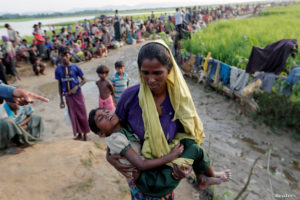By Marria Qibtia Sikandar Nagra
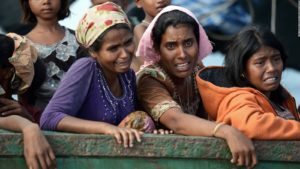 Migrating for Survival – The Rohingyas
Migrating for Survival – The Rohingyas
Where the Corona Virus pandemic has held the world in its tentacles, making survival an arduous task for the common man, life for Rohingya refugees in the midst of this crisis is no less than battling death in a Dantesque hell. Their trajectory comes to be accentuated by the corona virus pandemic, propelling a history of collective scarring and pain. Stateless and devoid of common acceptance, having nowhere to go, they exist rather than live. Where every day brings with it a fair share of communal struggle, hope is the only anchor that salvages their faith in the goodness of tomorrow.
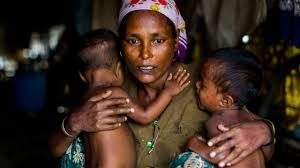 Who are the Rohingya and what accounts for their suffering ?
Who are the Rohingya and what accounts for their suffering ?
Quite simply put, the Rohingya are a Muslim ethnic minority group in Myanmar. Having denied citizenship by the government of Myanmar, they are stateless and hence are victims of blatant discrimination , denied of their basic rights as well as access to healthcare. Having been victims of decades long clashes with the government for being subjected to religious and ethnic discrimination, the Rohingya plight dates back to the 1800’s.
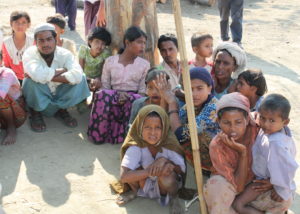 Under the British colonised rule, Myanmar witnessed an expansion of the Muslim population, which is said to have doubled in a span of 50 years! During the World War 2, severe differences arose between the Rohingya and the local Buddhist Myanmar. While the former supported the British, the latter ardently favoured the Japanese. Shortly after the war in the year 1948, Myanmar secured independence from the British colonial rule. What propelled then was a hardcore divide between the government and the Rohingya, transpiring in the governments prejudiced posturing.
Under the British colonised rule, Myanmar witnessed an expansion of the Muslim population, which is said to have doubled in a span of 50 years! During the World War 2, severe differences arose between the Rohingya and the local Buddhist Myanmar. While the former supported the British, the latter ardently favoured the Japanese. Shortly after the war in the year 1948, Myanmar secured independence from the British colonial rule. What propelled then was a hardcore divide between the government and the Rohingya, transpiring in the governments prejudiced posturing.
Since 27th August 2017, commencing an attack on the Myanmar police and the body guard posts by a disorganised Rohingya armed group, what propelled was a systematic campaign of violence against the Rohingya people in the northern Rakhine State. Since then, the world has witnessed an exodus of about one million Rohingya, who fled Myanmar fearing for their life and security.
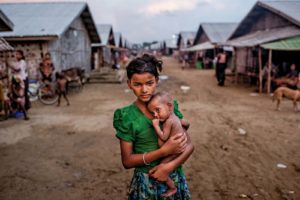 Where are Rohingya refugees located? At present about more than 1 million Rohingya are estimated to have fled their homes in Myanmar. About 914,000 of them are estimated to have sought refuge in nearby country Bangladesh on a narrow strip of hilly land in the Cox Bazar District which is now considered as the world’s largest refugee camp! From amongst these are 400, 000 refugee children who are denied an access to formal education since the teachers are barred from using both Myanmar and Bangladesh curricula in the camps while on the other hand the Rohingya children are not allowed to enrol in schools outside the camp.Around 100, 000 refugees are also settled in Malaysia. Since they do not have a legal status so are unable to work and fend for themselves and their families. About 40,000 refugees also fled to India. Considering the Rohingya to be illegal immigrants, the Indian government attempted to repatriate them back to Myanmar, inconsiderable of the tragedy that they fled in the first place! Some of the Rohingya also arrived by boats to Indonesia and Thailand. Infamous as the hub of human smuggling and trafficking , in Thailand the vulnerable Rohingya became victims of this menace , since in the bleakness that pervaded their circumstances , only this seemed a viable option for survival.
Where are Rohingya refugees located? At present about more than 1 million Rohingya are estimated to have fled their homes in Myanmar. About 914,000 of them are estimated to have sought refuge in nearby country Bangladesh on a narrow strip of hilly land in the Cox Bazar District which is now considered as the world’s largest refugee camp! From amongst these are 400, 000 refugee children who are denied an access to formal education since the teachers are barred from using both Myanmar and Bangladesh curricula in the camps while on the other hand the Rohingya children are not allowed to enrol in schools outside the camp.Around 100, 000 refugees are also settled in Malaysia. Since they do not have a legal status so are unable to work and fend for themselves and their families. About 40,000 refugees also fled to India. Considering the Rohingya to be illegal immigrants, the Indian government attempted to repatriate them back to Myanmar, inconsiderable of the tragedy that they fled in the first place! Some of the Rohingya also arrived by boats to Indonesia and Thailand. Infamous as the hub of human smuggling and trafficking , in Thailand the vulnerable Rohingya became victims of this menace , since in the bleakness that pervaded their circumstances , only this seemed a viable option for survival.
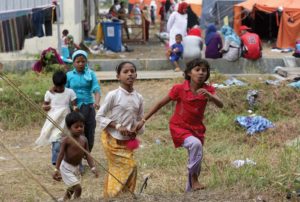 Life at Refugee Camps – Life at present at refugee camps is akin to living a nightmare for the Rohingya. The comfort of home and the sense of affinity that one attaches to his abode is a luxury inexperienced by the Rohingya , these camps are all where they can dwell. The makeshift arrangement of living at refugee camps, brings with it the uncertainty of the future , pregnant with the anxiety for tomorrow.In a refugee camp, since the conditions are very basic, needs tend to get even bigger. Scarcity of food qualifies children to be at a greater risk from malnutrition.
Life at Refugee Camps – Life at present at refugee camps is akin to living a nightmare for the Rohingya. The comfort of home and the sense of affinity that one attaches to his abode is a luxury inexperienced by the Rohingya , these camps are all where they can dwell. The makeshift arrangement of living at refugee camps, brings with it the uncertainty of the future , pregnant with the anxiety for tomorrow.In a refugee camp, since the conditions are very basic, needs tend to get even bigger. Scarcity of food qualifies children to be at a greater risk from malnutrition.
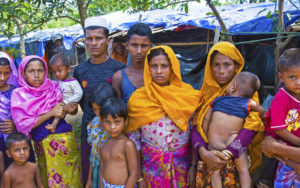 Similarly, expecting mothers suffer due to dietary insufficiencies lack of good healthcare. Since refugee camps are shelter in open lands, the threat from weather changes and seasonal changes is quite palpable. Be it heavy rainfalls, floods inundating the areas and water overflow, the probability of the spread of communicable diseases is a reality that cannot be overlooked. Diseases like cholera and dysentery spread fast , impacting children who are the primary victims of the Rohingya crisis. Also, since all the refugee settlements come to build from bamboo and tarps , the existential fear of shelter collapse is something that they have to battle with every single day.
Similarly, expecting mothers suffer due to dietary insufficiencies lack of good healthcare. Since refugee camps are shelter in open lands, the threat from weather changes and seasonal changes is quite palpable. Be it heavy rainfalls, floods inundating the areas and water overflow, the probability of the spread of communicable diseases is a reality that cannot be overlooked. Diseases like cholera and dysentery spread fast , impacting children who are the primary victims of the Rohingya crisis. Also, since all the refugee settlements come to build from bamboo and tarps , the existential fear of shelter collapse is something that they have to battle with every single day.
Psychological Impaction of the crisis – The Rohingya crisis has birthed psychological turmoil of the Rohingya population. The little innocent children, frolicking around the refugee camps are the worst hit victims of the conflict. With no sense of placement and comprehension of their suffering dynamics, these children are unaware of the uncertain future that awaits them. Fear , anxiety and helplessness are states that envelop the personas of the refugees. They do not know what to expect form their situation and where to look for help.To them the world sleeps on in slumber to their afflictions.
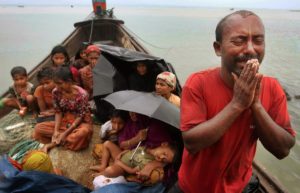 The way forward – The resolution of the Rohingya crisis in not an easy nut to crack. It will simply not resolve by encouraging the refugees to go back to their homes. Nor will it see the light of resolution, by making amicable arrangements for Rohingya for their reliant stay in refugee camps. Despite the involvement of global powers as US, Canada , Norway and South Korea who are continuously upping their humanitarian assistance or the participation of the Human Rights Watch , Amnesty International , and the likes of Arakan Project , a sustainable solution to the Rohingya crisis is not possible unless the culture of ethnic prejudice against the Rohingya by the Myanmar government is curbed. It is a continuous battle of overhauling attitudes , the success of which determines the future of Rohingya people.
The way forward – The resolution of the Rohingya crisis in not an easy nut to crack. It will simply not resolve by encouraging the refugees to go back to their homes. Nor will it see the light of resolution, by making amicable arrangements for Rohingya for their reliant stay in refugee camps. Despite the involvement of global powers as US, Canada , Norway and South Korea who are continuously upping their humanitarian assistance or the participation of the Human Rights Watch , Amnesty International , and the likes of Arakan Project , a sustainable solution to the Rohingya crisis is not possible unless the culture of ethnic prejudice against the Rohingya by the Myanmar government is curbed. It is a continuous battle of overhauling attitudes , the success of which determines the future of Rohingya people.

